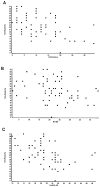A small randomized pilot study of a workplace mindfulness-based intervention for surgical intensive care unit personnel: effects on salivary α-amylase levels
- PMID: 25629803
- PMCID: PMC4624325
- DOI: 10.1097/JOM.0000000000000371
A small randomized pilot study of a workplace mindfulness-based intervention for surgical intensive care unit personnel: effects on salivary α-amylase levels
Abstract
Objective: To determine whether a workplace stress-reduction intervention decreases reactivity to stress among personnel exposed to a highly stressful occupational environment.
Methods: Personnel from a surgical intensive care unit were randomized to a stress-reduction intervention or a waitlist control group. The 8-week group mindfulness-based intervention included mindfulness, gentle yoga, and music. Psychological and biological markers of stress were measured 1 week before and 1 week after the intervention.
Results: Levels of salivary α-amylase, an index of sympathetic activation, were significantly decreased between the first and second assessments in the intervention group with no changes in the control group. There was a positive correlation between salivary α-amylase levels and burnout scores.
Conclusions: These data suggest that this type of intervention could decrease not only reactivity to stress but also the risk of burnout.
Conflict of interest statement
Figures




References
-
- McCraty R, Atkinson M, Tomasino D. Impact of a workplace stress reduction program on blood pressure and emotional health in hypertensive employees. J Altern Complem Med. 2003;9:355–369. - PubMed
-
- Lambert VA, Lambert CE. Literature review of role stress/strain on nurses: an international perspective. Nurs Health Sci. 2001;3:161–172. - PubMed
-
- Lambert VA, Lambert CE, Itano J, Inouye J, Kim S, Kuniviktikul W, Sitthimongkol Y, Pongthavomkamol K, Gasemgitvattana S, Ito M. Cross-cultural comparison of workplace stressors, ways of coping and demographic characteristics as predictors of physical and mental health among hospital nurses in Japan, Thailand, South Korea and the USA (Hawaii) Int J Nurs Stud. 2004;41:671–84. - PubMed
-
- Shanafelt TD, Balch CM, Bechamps G, Russell T, Dyrbye L, Satele D, Collicott P, Novotny P, Sloan J, Freischlag J. Burnout and Medical Errors Among American Surgeons. Ann Surg. 2010;251:995–1000. - PubMed
-
- Chang EM, Daly J, Hancock KM, Bidewell JW, Johnson A, Lambert VA, Lambert CE. The relationships among workplace stressors, coping methods, demographic characteristics and health in Australian nurses. J Prof Nurs. 2006;22:30–38. - PubMed
Publication types
MeSH terms
Substances
Grants and funding
LinkOut - more resources
Full Text Sources
Medical

